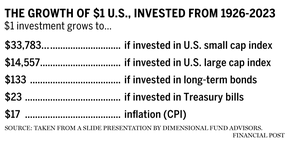The issue with investing closely in GICs in retirement

Critiques and suggestions are unbiased and merchandise are independently chosen. Postmedia might earn an affiliate fee from purchases made by means of hyperlinks on this web page.
Article content material
By Julie Cazzin with Allan Norman
Q: My spouse and I are each 62, semi-retired, working two to 3 days per week incomes $15,000 to $20,000 mixed. We’re inquisitive about recommendation round Canada Pension Plan (CPP), Previous Age Safety (OAS) and the clawback, in addition to registered retirement financial savings plans (RRSPs), registered retirement Revenue funds (RRIFs) and tax-free financial savings accounts (TFSAs). I’ve an listed pension of $79,500 dropping to $69,500 at age 65 and I count on full CPP, whereas my spouse expects 50 per cent. We’re conservative buyers and solely put money into assured funding certificates (GICs). I’ve a $90,000 TFSA and $13,000 RRSP, my spouse has a $110,000 TFSA, $580,000 RRSP, and $580,000 non-registered account. Now we have no money owed, three kids, and our home is price $1.2 million. We love travelling and we reside on my pension and our earnings, which is about $73,000 per yr after tax. Any recommendation you can provide us on our investments going ahead is appreciated. — Rudy
Commercial 2
Article content material
FP Solutions: Rudy, U.S. creator and researcher Wade Pfau, a professor on the American Faculty of Monetary Providers, describes and researches two completely different approaches to retirement planning — safety-first and likelihood. You’re leaning towards the safety-first strategy and my guess is that almost all monetary planners, together with what you could learn within the paper, lean towards a likelihood strategy to retirement planning.
Article content material
The likelihood strategy goes one thing like this: Spend money on, and maintain, a sure stage of equities in your portfolio and if these equities carry out at, or near, historic ranges, you need to be okay.
A fast look at desk 1 under confirms equities have outperformed safer investments like bonds and treasury payments so why even contemplate a safety-first strategy?
The problem with the likelihood strategy is that historic returns are random, and also you don’t know when the returns will seem, or even when they may seem inside your funding time-frame. Plus, there is no such thing as a assure you’ll seize the historic returns resulting from your funding decisions and selections.
Article content material
Commercial 3
Article content material
A security-first strategy provides ensures to your monetary plan, together with annuities for earnings and life insurance coverage to go away a legacy or property.
Rudy, in your case you will have a pension, CPP, and OAS, all of that are listed and are thought-about annuities. You’re additionally holding GICs guaranteeing your capital however not your buying energy resulting from inflation. That is the alternative of equities, which don’t assure your capital however might present inflation safety as seen traditionally in Desk 1.
Inflation threat, in my opinion, is among the largest threats that retirees face, much more so than the jarring emotional affect of market volatility. Aside from the previous few years, inflation sneaks up on you slowly and quietly, till sooner or later you discover you possibly can not afford what you as soon as have been capable of. For a retiree there is no such thing as a actual restoration as soon as inflation takes maintain.

Within the desk above, you possibly can see that $1 invested on the price of inflation in 1926 could be price $17 right now. Which means that costs in 2023 are 17 occasions extra on common than they have been in 1926.
In your case, Rudy, your listed pension, CPP and OAS will defend you from inflation threat since you don’t have spending plans that depend on your GIC financial savings. When you attain age 65 your pension bridge profit will drop off and your pension can be decreased by $10,000. Nevertheless, your CPP and OAS at the moment will whole near $23,000 per yr, greater than making up for the pension lower.
Commercial 4
Article content material
Contemplate delaying your CPP and OAS to age 70 to maximise your lifetime CPP and OAS advantages. The 2 figuring out components of when to begin CPP and OAS, if you wish to maximize the advantages, are based mostly in your future anticipated funding returns and your life expectancy, each of that are unknown. The decrease your anticipated returns, the extra it is smart to delay CPP and OAS; the shorter your life expectancy, the extra it is smart to begin CPP and OAS early.
Rudy, after age 65, for every year you delay CPP to age 70, it will increase by 8.4 per cent and OAS will increase by 7.2 per cent. As a GIC investor, you aren’t going to beat that. Take into consideration changing your RRSPs to a RRIF at age 65 after which drawing sufficient out of your RRIFs every year to age 70, changing what you’d have acquired in CPP and OAS funds. If, for some cause, your part-time work results in extra earnings and also you don’t want a RRIF earnings, you possibly can at all times convert the RRIF again to an RRSP earlier than the yr you flip 72.
Changing to a RRIF has many advantages. It should let you cut up pension earnings along with your spouse and keep away from OAS clawback, your spouse will be capable to declare the $2,000 pension tax credit score, and you’ll management the quantity of withholding tax taken on minimal RRIF withdrawals.
Commercial 5
Article content material
Rudy, it looks as if you and your spouse are in good condition and lucky to have the ability to take a safety-first strategy to retirement whereas sustaining your life-style. Many {couples} and people are reliant on the probability-based strategy to fund their retirement. My query to you is, “What are you going to do along with your GIC financial savings in case you solely plan to reside in your pension, CPP and OAS?” The query to ask your self is, “If I transformed a few of that GIC cash to an annuity, would I be extra prone to spend, and make higher use of the cash?” If the reply is sure, then changing a few of your GIC cash to an annuity could possibly be a great possibility for you and your spouse.
Allan Norman, M.Sc., CFP, CIM, offers fee-only licensed monetary planning companies and insurance coverage merchandise by means of Atlantis Monetary Inc. and offers funding advisory companies by means of Aligned Capital Companions Inc., which is regulated by the Canadian Funding Regulatory Group. He could be reached at alnorman@atlantisfinancial.ca.
Bookmark our web site and help our journalism: Don’t miss the enterprise information you might want to know — add financialpost.com to your bookmarks and join our newsletters right here.
Article content material